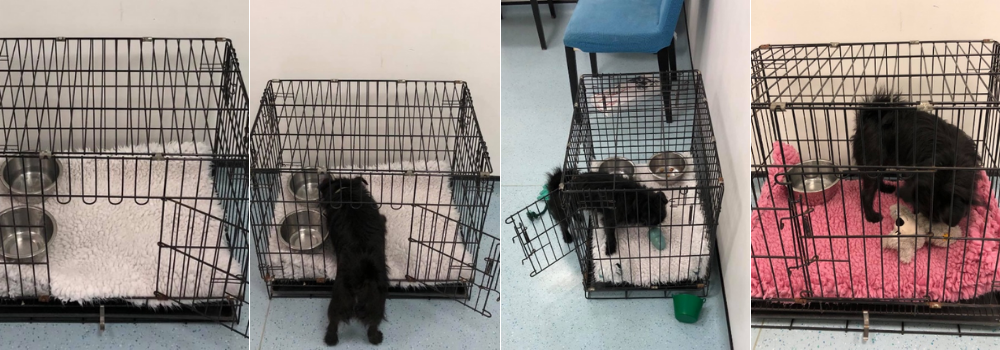Crate training is essential. Using a crate helps provide a puppy/dog with its own private safe place.
For owners, it helps with toilet training and provides a safe area for the dogs/puppies to be left alone for short periods of time. However, if the crate has not been introduced correctly to the puppy/dog it will create a place that the dog is frightened of. This can lead to an increase in behavioural problems such as barking, loss of toilet control and aggression.
We share tips on crate training for puppies and dogs.
Crate Size
This needs to be big enough for the dog to be able to stand up, sit down and stretch. Remember, if you are using it for a puppy you will need to upgrade to the next size as the puppy grows.
Crate Location
Provide an area that is easily accessible for the puppy to go to.
An important aspect of crate training is having the crate where the puppy can have peace and quiet in order to relax and calm down. It also teaches the puppy to be isolated away from the family.
You can have the crate location in the main family areas so your puppy can get used to the comings and goings of a busy family especially if you have children.
What Should Be In The Crate?
A comfy bed, toys and food/water bowl.
Introducing The Crate and Crate Training to Your Dog

- Ensure the crate is big enough for your dog to lie down, stand up and turn around in, with access to food and water
- Let your dog have a look around the crate. Do not approach or attempt to close the crate door even if your dog seems happy inside the crate
- Start to give every meal in the crate but do not close the crate door at this stage
- If your dog starts to go in the crate during the day, always reward them with a treat
- Place food in interactive feeders such as a Kong into the crate to encourage your dog to stay in the crate between mealtimes
- Once your dog is settling in the crate start to close the door. As soon as they finish eating open the crate door again
- Gradually leave the crate door closed for longer after your dog has eaten meals/treats or a stuffed Kong. Start by leaving for one minute and slowly increase the time
- When your dog is happy in the crate for 5 minutes with the door closed, start to walk away from the crate into another room and then come back and open the crate door
- Slowly increase the time you are away from your dog by a minute at a time. Once your dog is happy waiting for you to return after a few minutes you can move onto the last stage in crate training
- Before you leave your dog in the crate overnight or to go to work, you need to get them used to triggers. These are things like closing doors, turning lights off, putting coats on and picking up keys. Practice doing these things whilst your dog is in the crate for a few days before doing it for real.
Problems
Barking/Whining
Make sure puppy/dog is quiet before opening the crate. Start by opening the door just before your puppy finishes their food and slowly extend the time after feeding.
Make sure the dog is quiet before opening the crate so it does not learn that barking or whining is what makes the crate door open.
An Adaptil diffuser placed next to the crate will help the puppy feel more relaxed in the area reducing the chance of barking/whining to occur.
Reluctance On Going Into The Crate
If the owners have been moving the stage of introducing the crate too quickly, give more frequent food treats in the crate without closing the door, to get the dog to want to go into the area.
Provide high value treats such as a stuffed Kong. This is to make sure the dog is happy to start to play/eat. Close the door for a few seconds before opening the crate again. Over a few days slowly start to increase the length of time door is closed.
Never pick the puppy up to place into the crate. It should always want to go in on its own.
Kat Johnson RVN Dip Instructor is a long standing member of our Nursing Team who runs our puppy and dog training classes.